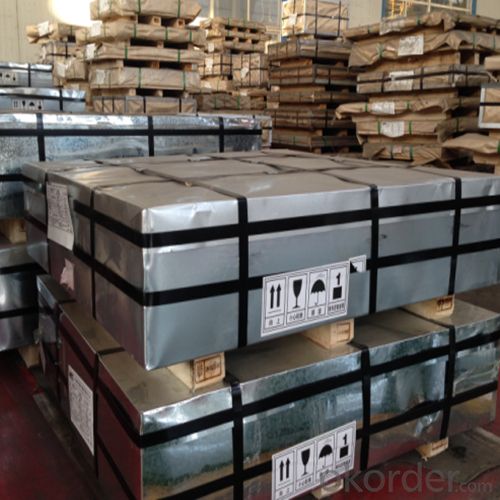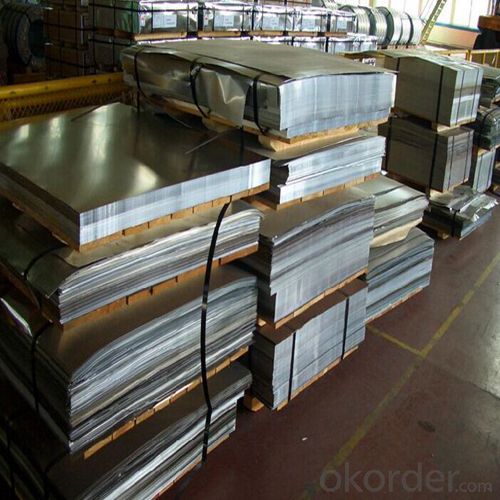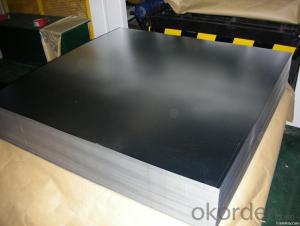Tinplate Coil / Sheet for Foods Can Packaging
- Loading Port:
- Tianjin
- Payment Terms:
- TT or LC
- Min Order Qty:
- 25 m.t
- Supply Capability:
- 7000 m.t/month
OKorder Service Pledge
OKorder Financial Service
You Might Also Like
1.Structure of Electrolytic Tin Plate Coils and Sheets for Foods Metal Packaging Description
Electrolytic Tin Plate Coils and Sheets for Foods Metal Packaging, is one thin steel sheet with a coating of tin applied by electrolytic deposition. Tinplate made by this process is essentially a sandwich in which the central core is strip steel. This core is cleaned in a pickling solution and then fed through tanks containing electrolyte, where tin is deposited on both sides. As the strip passes between high-frequency electric induction coils, it is heated so that the tin coating melts and flows to form a lustrous coat.
2.Main Features of the Electrolytic Tin Plate Coils and Sheets for Foods Metal Packaging
Tinplate, thin steel sheet with a coating of tin applied either by dipping in molten metal or by electrolytic deposition; almost all tinplate is now produced by the latter process. Tinplate made by this process is essentially a sandwich in which the central core is strip steel. This core is cleaned in a pickling solution and then fed through tanks containing electrolyte, where tin is deposited on both sides. As the strip passes between high-frequency electric induction coils, it is heated so that the tin coating melts and flows to form a lustrous coat.
3.Electrolytic Tin Plate Coils and Sheets for Foods Metal Packaging Images



4.Electrolytic Tin Plate Coils and Sheets for Foods Metal Packaging Specification
Standard | ISO 11949 -1995, GB/T2520-2000,JIS G3303,ASTM A623, BS EN 10202
|
Material | MR,SPCC |
Thickness | 0.15mm - 0.50mm |
Width | 600mm -1150mm |
Temper | T1-T5 |
Annealing | BA & CA |
Coil Inner Diameter | 508mm |
Weight | 6-10 tons/coil 1~1.7 tons/sheets bundle |
Passivation | 311 |
Oil | DOS |
Surface | Finish,bright,stone,matte,silver |
5.FAQ of Electrolytic Tin Plate Coils and Sheets for Foods Metal Packaging
-What your tinplate material is used for ?
Tinplate is widely used for the packaging of products. Such as food cans,
beverage cans, pet cans, closures, general line cans and so on.
Printed Tinplate is offered!!
-How to place .an order or contact you ?
Please send us Email. we will give you a quick response in seconds .
- How is your quality ?
All our quality is prime even the secondary quality . We have many years experience
In this field with serious quality control standard . Advanced equipment, We welcome your visit to our factory .
- Q:What are the common defects found in tinplate packaging?
- Common defects found in tinplate packaging include: 1. Corrosion: Tinplate can be prone to corrosion, resulting in rust spots or holes in the packaging. This can compromise the integrity of the packaging and affect the quality and safety of the product inside. 2. Dents and scratches: During handling or transportation, tinplate packaging can get dented or scratched. These defects can be purely cosmetic, but in some cases, they may lead to leaks or damage to the product. 3. Poor sealing: Improper sealing of tinplate packaging can lead to leaks or contamination of the product. This can occur due to faulty machinery or inadequate quality control during the packaging process. 4. Print defects: Tinplate packaging often includes printed information or branding. Common defects in this area include misalignment, smudging, fading, or incomplete printing. These defects can affect the visual appeal of the packaging and the overall product presentation. 5. Manufacturing defects: Tinplate packaging can sometimes have manufacturing defects such as uneven edges, poor welds, or misaligned seams. These defects may weaken the packaging structure or cause sharp edges that could potentially harm consumers. It is important for manufacturers to have strict quality control measures in place to identify and rectify these defects, ensuring the safety, functionality, and aesthetics of tinplate packaging.
- Q:How does tinplate packaging contribute to product aesthetics?
- Tinplate packaging contributes to product aesthetics by providing a visually appealing and attractive presentation. The shiny and smooth surface of tinplate enhances the overall look of the packaging, giving it a premium and high-quality feel. Additionally, tinplate allows for intricate designs, embossing, and printing techniques, allowing brands to create eye-catching graphics and logos that further enhance the visual appeal of the product.
- Q:How is tinplate coated for cosmetic packaging?
- Tinplate is typically coated for cosmetic packaging through a process called electrolytic tin plating. This involves immersing the tinplate in a bath containing a tin salt solution and passing an electric current through it. As a result, a layer of tin is deposited onto the surface of the tinplate, providing a protective coating that prevents corrosion and enhances the overall aesthetics of the packaging.
- Q:What are the different types of tinplate edge finishes?
- There are three main types of tinplate edge finishes: single edge, double edge, and scroll edge.
- Q:How does tinplate affect the overall product shelf appeal?
- Tinplate can significantly enhance the overall product shelf appeal by providing a visually attractive and premium packaging solution. Its metallic appearance and smooth finish can give a sense of elegance and quality to the product, making it stand out among competitors on the shelves. Additionally, tinplate allows for creative and eye-catching designs, ensuring that the product grabs the attention of potential customers and entices them to make a purchase.
- Q:How does tinplate packaging contribute to product protection during shipping?
- Tinplate packaging provides effective protection during shipping due to its durability and strength. It acts as a sturdy barrier against external elements, such as moisture, light, and air, which can potentially damage the product. Tinplate packaging also offers resistance to corrosion, ensuring the product's integrity throughout the shipping process. Its robust construction provides cushioning and prevents the product from being easily crushed or dented. Overall, tinplate packaging plays a crucial role in safeguarding the product from various risks, ensuring it reaches the destination in optimal condition.
- Q:What are the common industry standards for tinplate?
- The common industry standards for tinplate include specifications for the thickness, temper, coating weight, and surface finish. Additionally, the standards outline requirements for the mechanical properties, such as elongation and hardness, as well as the chemical composition of the tin coating. These standards ensure consistent quality and compatibility across different manufacturers and applications in the tinplate industry.
- Q:How is tinplate used in the construction industry?
- Tinplate is commonly used in the construction industry for various applications. It is primarily utilized for roofing and cladding purposes due to its durability, corrosion resistance, and aesthetic appeal. Tinplate sheets are often employed in the construction of warehouses, industrial buildings, and residential structures as a protective outer layer. Additionally, tinplate can be used for decorative purposes, such as wall panels or ceiling tiles, adding a sleek and modern look to buildings.
- Q:Can tinplate packaging be used for personal care products?
- Yes, tinplate packaging can be used for personal care products. Tinplate is a durable and versatile material that provides excellent protection for various products, including cosmetics, lotions, and other personal care items. Its ability to resist corrosion and maintain the product's quality makes it a suitable choice for packaging in the personal care industry.
- Q:How does tinplate perform in terms of resistance to UV radiation?
- Tinplate generally has poor resistance to UV radiation. Without proper protective coatings or treatments, tinplate is susceptible to degradation and discoloration when exposed to prolonged sunlight or UV radiation.
1. Manufacturer Overview |
|
|---|---|
| Location | |
| Year Established | |
| Annual Output Value | |
| Main Markets | |
| Company Certifications | |
2. Manufacturer Certificates |
|
|---|---|
| a) Certification Name | |
| Range | |
| Reference | |
| Validity Period | |
3. Manufacturer Capability |
|
|---|---|
| a)Trade Capacity | |
| Nearest Port | |
| Export Percentage | |
| No.of Employees in Trade Department | |
| Language Spoken: | |
| b)Factory Information | |
| Factory Size: | |
| No. of Production Lines | |
| Contract Manufacturing | |
| Product Price Range | |
Send your message to us
Tinplate Coil / Sheet for Foods Can Packaging
- Loading Port:
- Tianjin
- Payment Terms:
- TT or LC
- Min Order Qty:
- 25 m.t
- Supply Capability:
- 7000 m.t/month
OKorder Service Pledge
OKorder Financial Service
Similar products
New products
Hot products
Related keywords



























